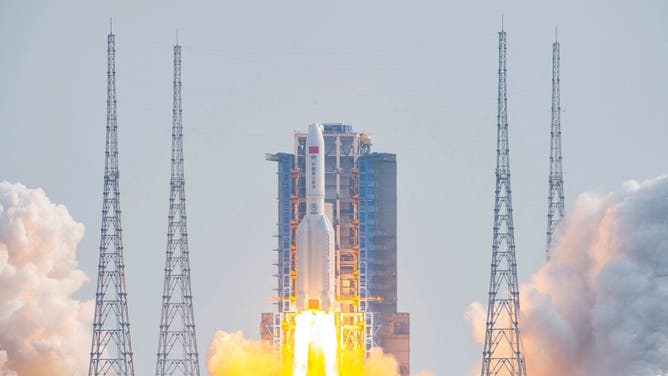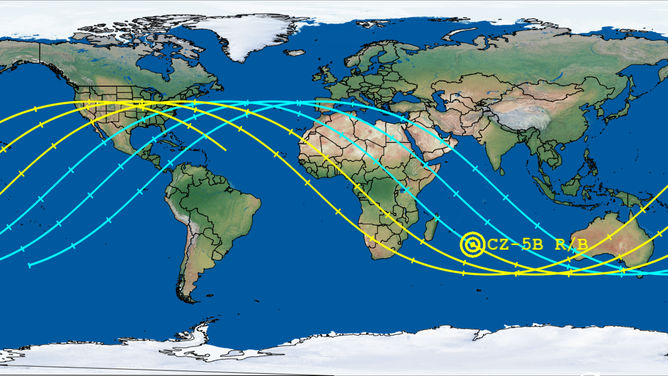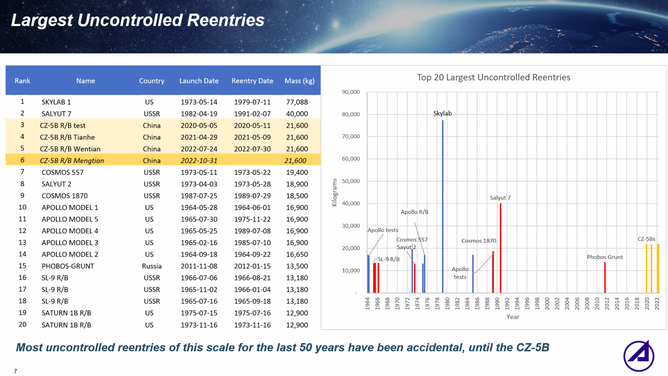'Here we go again:' Chinese rocket booster crashes back to Earth over Pacific Ocean
The U.S. Space Command confirmed pieces of the rocket splashed down in two areas of the Pacific Ocean early Friday morning. About 88% of the population was at some risk with this week's reentry but were still more likely to win the lottery than get hit by falling space junk.

A Long March 5B rocket, carrying China's Mengtian science module, the final module of Tiangong space station, lifts off from the Wenchang Space Launch Centre in southern China's Hainan Province on October 31, 2022. (Photo by -/CNS/AFP via Getty Images)
(Getty Images)
A Chinese rocket booster tumbled back to Earth on Friday during an uncontrolled reentry into the Pacific Ocean, marking the fourth time in two years for a haphazard crash of a rocket from China.
On Oct. 31, China launched the final module of its Tiangong Space Station on a Long March 5B rocket. About a week later, the rocket booster, about the size of two tractor-trailers, made an unplanned reentry into Earth's atmosphere, which experts said goes well above the 1 in 10,000 level of risk accepted by NASA and most nations with space programs.
U.S. Space Command confirmed pieces of the rocket splashed down in two areas of the Pacific Ocean early Friday morning.
HOW TO WATCH FOX WEATHER ON TV
NASA Administrator Bill Nelson condemned the People's Republic of China for the reentry calling it an "unnecessary risk."
"They did not share specific trajectory information which is needed to predict landing zones and reduce risk," Nelson said in a statement. "This is the PRC’s fourth uncontrolled reentry since May 2020, and each of these reentries have been the largest in last 30 years. It is critical that all spacefaring nations are responsible and transparent in their space activities and follow established best practices, especially, for the uncontrolled reentry of a large rocket body debris – debris that could very well result in major damage or loss of life."
Aerospace Corporation's Center for Orbital and Reentry Debris Studies (CORDS) had been publicly tracking the rocket body known as CZ-5B and sharing its reentry predictions.
Previous launches of Long March rockets also made uncontrolled reentries. Between 20% and 40% of the 24-ton booster is expected to survive its plummet to Earth.
"Here we go again," CORDS reentry and debris expert Ted Muelhaupt told reporters on Wednesday.
On July 24, a Long March-5B Y3 rocket launched from the Wenchang Space Launch Site in China, sending up the laboratory module for the orbiting station. The 25-ton rocket booster came tumbling back to Earth on July 30 over Southeast Asia. Witnesses in Malaysia reported seeing bright objects in the sky that resembled meteors but said it was likely debris. According to images shared by Aerospace Corp., part of the rocket fairing or nose cone landed in the Philippine Sea.
WHY A SPACECRAFT CLAW WAS BUILT TO CLEAN UP SPACE JUNK
In May 2021, a Long March rocket booster plummeted back to Earth, causing property damage on the Arabian Peninsula.
These unplanned reentries left "big chunks of metal where people are," Muelhaupt said.
How predicting a falling rocket is like forecasting hurricanes

Aerospace Corporation's reentry prediction model shows possible reentry locations of the Chinese Long March 5B booster lie anywhere along the blue and yellow ground track. Areas not under the line are not exposed to the debris. (Image: Aerospace Corporation)
Ahead of the crash, experts said it was easier to say where the rocket would not fall than where it would fall.
Most of Europe was too far north, and in the U.S., areas north of Chicago were out of CORDS' current model by Thursday night. The models did include the lower half of North America, Africa and most of Australia.
Lael Woods, a space traffic management expert at Aerospace Corp., compared debris modeling to spaghetti models used for tracking Hurricane Ian.
WHAT IS THE 'CONE OF UNCERTAINTY' IN HURRICANE FORECASTS?
"We knew it was going to hit Florida," Woods said. "We didn't know exactly where on Florida it would hit, but as we got closer to the actual event, it got more clear. So, knowing all the conditions that feed into understanding when a hurricane is going to hit (is) very similar to this, as far as there are all sorts of data that if we knew every little detail, our models would be much better."
If China provided information about what the rocket was made of and other factors, the models would be more accurate, experts said. For example, knowing if the rocket was made of aluminum, which has a lower melting point, or titanium, which can survive intense heat on reentry, would help researchers know how much of the rocket body will survive its fall back to Earth and the associated risk.
"How is it built? What is the structure like? What is it made of? How is it distributed within the vehicle? All of that is hard data that the Chinese could supply for the world, for others to improve their predictions," Muelhaupt said. "Without it, it's really hard for us to improve our models."
DEBUNKING 7 MYTHS ABOUT LIGHTNING
The Aerospace Corp. trajectory placed the rocket plummeting back to Earth on Friday about 8:24 a.m. EDT – plus or minus 4 hours. About 88% of the world's population, or 7 billion people, were at risk. According to the U.S. Space Command, reentry happened about 6 a.m. EDT.
However, even for those under the reentry risk zone, the chances of getting hit by a piece of this booster falling from the sky were still less than winning the lottery or getting struck by lightning.
"You're 80,000 times more likely to get hit by lightning," Muelhaupt said. "Nobody has to alter their lives because of this unless you're a first responder."
Making plans for safely falling to Earth

The largest uncontrolled reentries, include SkyLab, Apollo models and several Chinese rocket boosters. (Image: Aerospace Corp.)
Rocket parts, satellites and other defunct space hardware fall back to Earth frequently. About 50 objects weighing more than a ton reenter randomly throughout a year, according to Muelhaupt.
"We, the world, don't deliberately launch things this big and intend them to fall wherever," Muelhaupt said. "We haven't done that for 50 years. All the large reentries that have been uncontrolled in the last 50 years, except for these, were accidents. Something went wrong."
Rocket debris from the Long March rocket makes up the third-, fourth-, fifth- and sixth-largest uncontrolled reentries ever, according to CORDS data. The largest piece of space debris to make an uncontrolled reentry was Skylab 1 in 1979. NASA made attempts to manage SkyLab's tumble to Earth, but some pieces still fell in Western Australia.
Most counties with space programs require reentry plans for human-made space objects.
Thirteen national and international space agencies have agreed on recommendations that causality chances -- meaning injury or death -- be less than 1 in 10,000 for a reentry. These common guidelines apply to commercial and government launches. Still, on an international level, there is no binding legal way for what a company or agency can do for reentry, according to Marlon Sorge, executive director of CORDS.
AGAIN? ANOTHER CHINESE ROCKET BOOSTER CRASHES BACK TO EARTH
"The reason it's been so difficult to come to an agreement on exactly what the numbers should be for this is that you're talking about risk to human beings and different countries have different interpretations of what an acceptable risk is for people," Sorge said.
Two out of three recent CZ-5B launches have dumped big chunks of metal over areas with people but have not resulted in any injuries.
CORDS and other experts are advocating for all contributors to the space industry to adapt launch hardware to avoid these situations altogether, which is possible given spaceflight technology today. The ability to control the vehicle's attitude or restart the rocket motor for reentry can control where and when a rocket comes barreling back to Earth.
"We really don't want an international catastrophe to drive change," Woods said. "We want to drive change now."